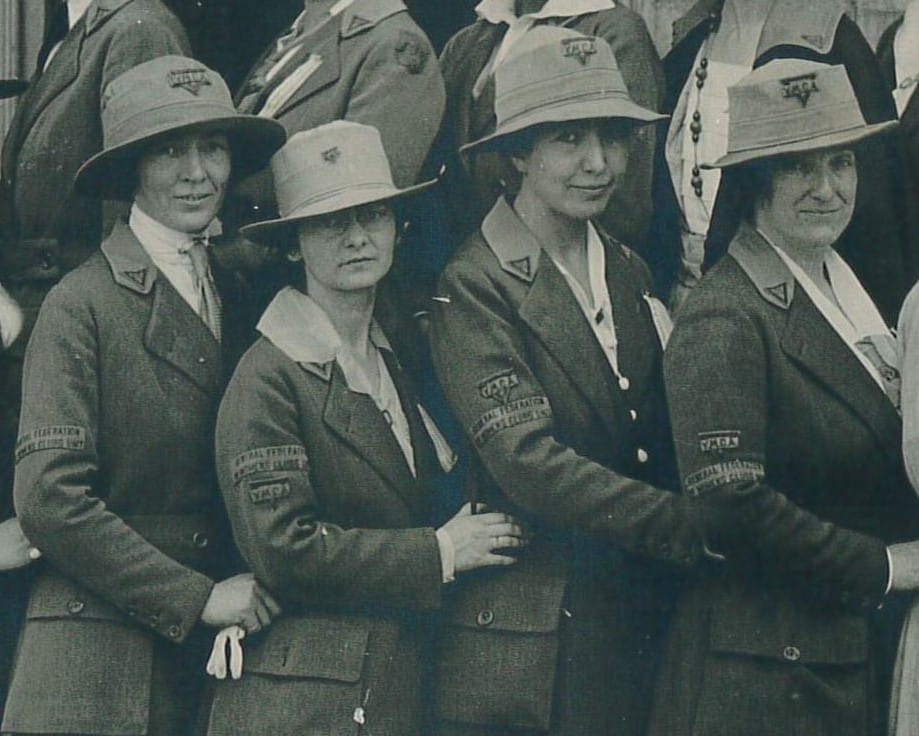
WHRC: From the Archives
Freddie Hilp and the GFWC Overseas Unit
By: Joanna Church, Women’s History and Resource Center Librarian
Welcome back to our new monthly blog series, direct from the GFWC Women’s History and Resource Center! Here, we’ll highlight stories of General Federation history, pulled from our unique archival, photograph, and artifact collections. Check back on the first Thursday of each month for a new post.
During World War I, the General Federation of Women’s Clubs formed a War Victory Commission to identify projects and raise funds to support the war effort. One major area of concern was the need for wholesome recreation opportunities for U.S. servicemen, especially after the November 1918 Armistice when troops waited many months for transportation home. Organizations like the American Red Cross, the YMCA and YWCA, the American Library Association, and the Jewish Welfare Board worked together to supply refreshment, recreation, and entertainment to the American Expeditionary Forces; GFWC joined in by recruiting several dozen women from across the country for a new “GFWC Unit for Overseas Service.” These women were assigned canteen duty in France, Belgium, and Germany: serving refreshments, hosting dances, and boosting morale.

GFWC Overseas Unit members, 1920. Their YMCA uniforms are embellished with “General Federation of Women’s Clubs” armbands. (See full photograph at bottom of this post.)
The GFWC Overseas Unit members were not necessarily clubwomen themselves, but we expected these “Daughters of the Federation” to represent our organization while in Europe. GFWC President Ione Cowles entreated them “to exemplify for us the fine spirit of consecrated American womanhood,” helping to remind the troops of what they had fought for and who was waiting for them (mothers, wives, sweethearts) at home.

In a report to the Federation in 1920, Unit member Hallie Jamieson described the “love and ideals of the womanhood of America” that GFWC sent abroad with the Unit. She also claimed to have heard soldiers respond positively (if, at first, with confusion) upon reading her GFWC armband. Click here to read the full Overseas Unit Report from the 1920 Biennial Convention.
After the war, we invited members of the Unit to attend the 1920 GFWC Biennial convention in Des Moines, in order to give them a specially-designed “decoration”: an ornate gold pin, engraved with each woman’s name. (We also very much wanted to bring these women into the GFWC fold and encourage them to join their local women’s clubs, but it’s unclear if that effort was particularly successful.) Unfortunately, GFWC’s record-keeping in this era trended toward finished reports rather than working papers; thus, we didn’t have many details about the Unit other than what was recorded in convention records and the GFWC magazine.
In the 2000s this lack of detail was greatly improved, thanks to the donation of 263 photographs taken by Unit member Freddie Hilp.
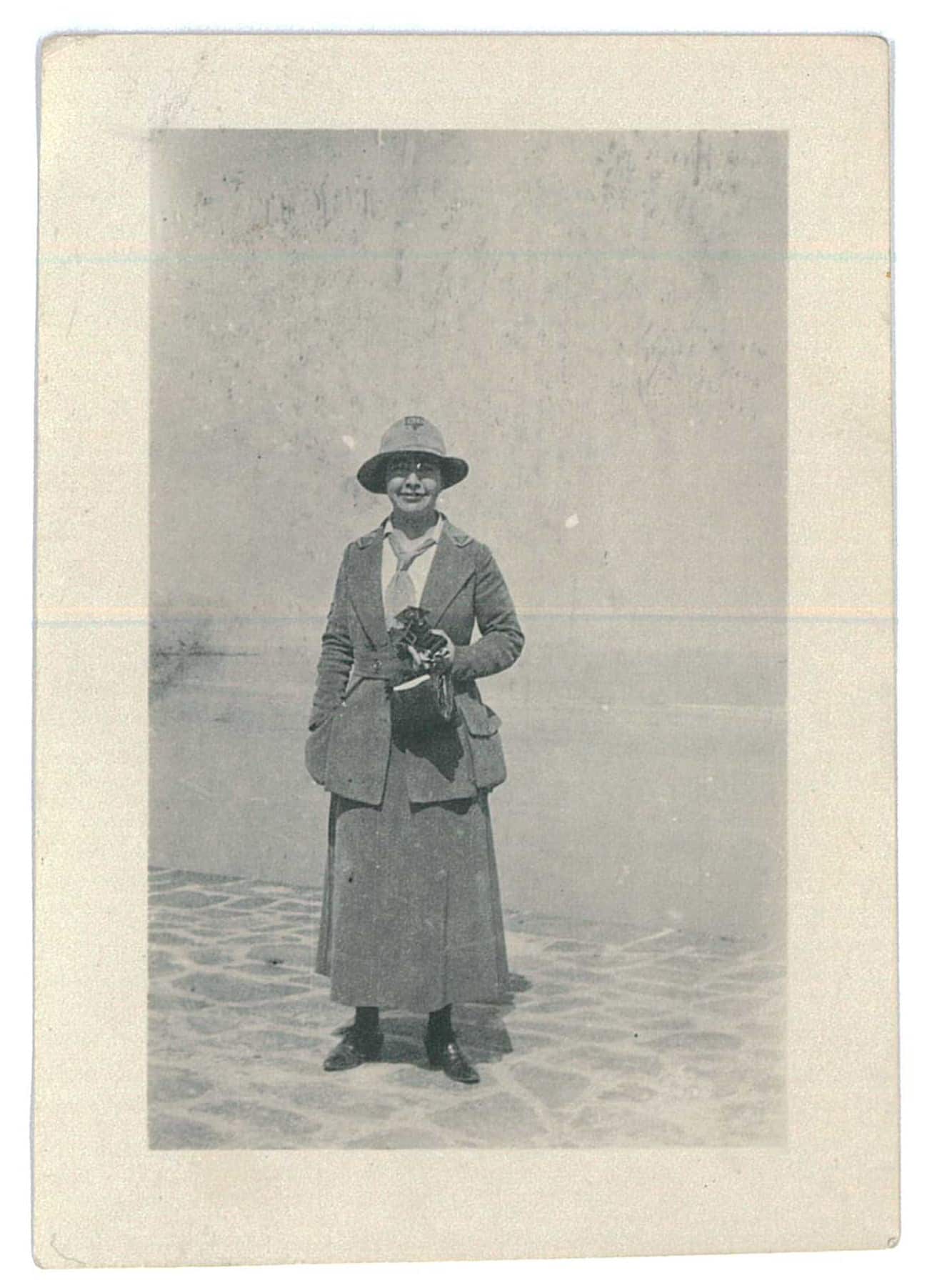
29 year old Blanche Frederika “Freddie” Hilp was working for
the Nevada State Council of Defense when she learned of the GFWC Overseas Unit opportunity. She applied through the Nevada Federation of Women’s Clubs, was accepted, and ended up assigned to one of the YMCA’s “rolling canteens.” From March to July 1919, she drove around the French countryside with chocolate, lemonade, and other goodies, delivering comfort to troops who couldn’t travel to a stationary canteen.
Freddie Hilp, in uniform and holding her camera, on a beach in France, 1919.
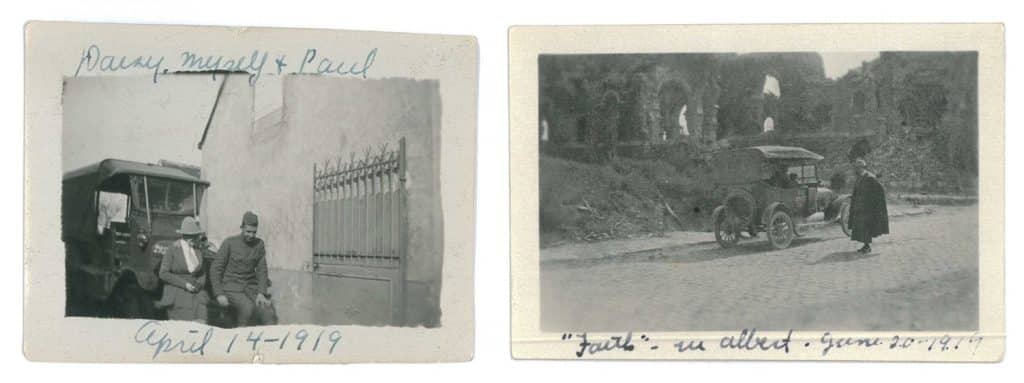
During her trip, Freddie drove or rode in at least two different canteen vehicles, probably decommissioned ambulances, which she nicknamed Daisy and Faith. Left: “Daisy, myself & Paul April 14-1919” Right: “‘Faith’ – in Albert. June 20 1919″
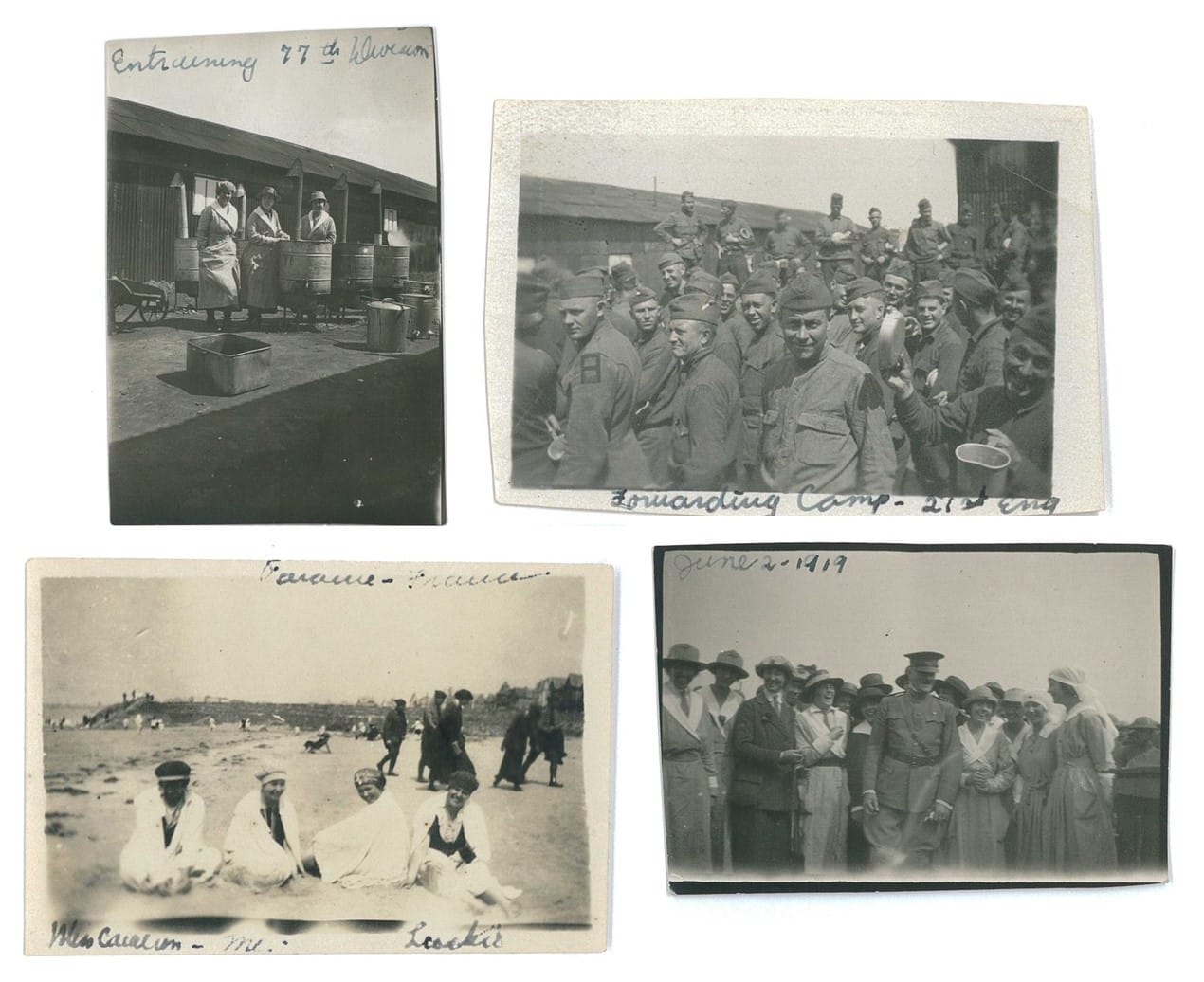
Fortunately for us, Freddie brought along her camera. She snapped photos of new friends; of the servicemen she and her colleagues encountered; of historic sites and French residents; of working days, and time off for fun.
Top left: “Entraining 77th Division” Top right: “Forwarding Camp – 21st Eng” Bottom left: Parame – France. Miss Carlson [?], me, [unnamed], Luckie” Bottom right: General Pershing visited the camp on “June 2 1919”
Freddie also documented the devastation wrought by the war. Amidst her cheerful snapshots are poignant photos of ruined towns, blighted landscapes, barbed wire, and newly-dug cemeteries.
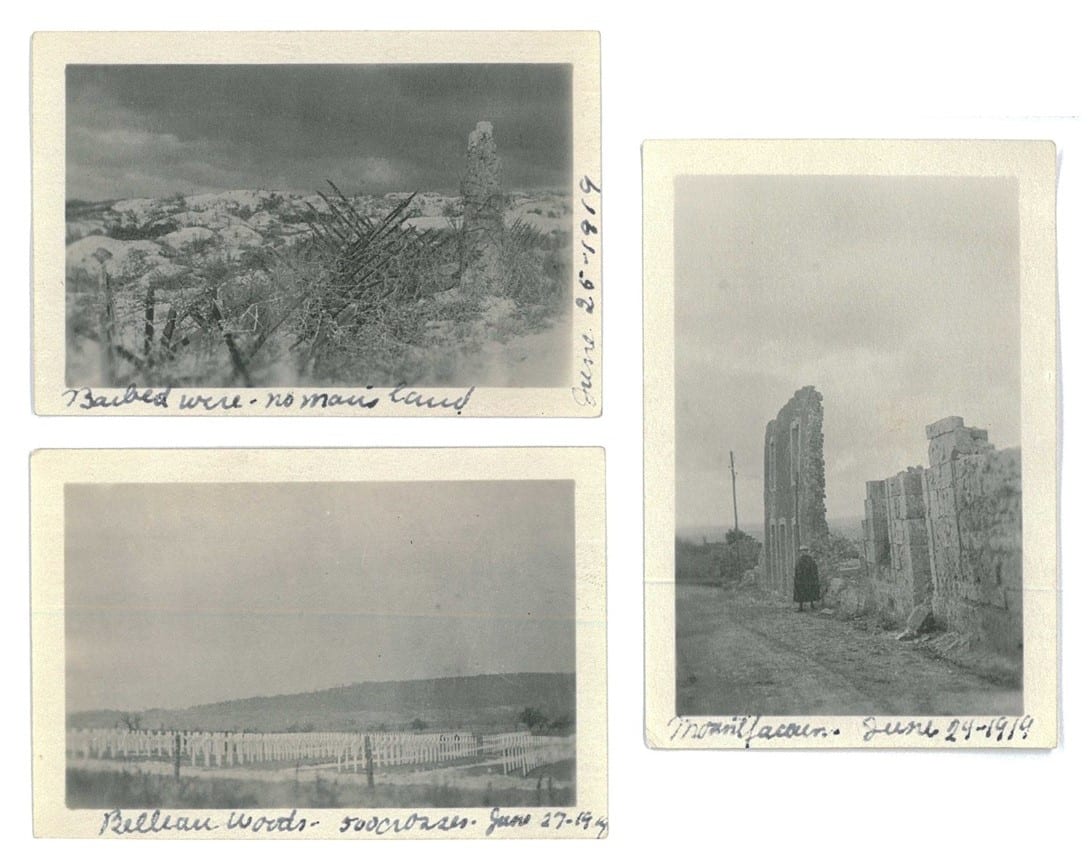
Top left: “Barbed wire – no man’s land. June 25 1919″ Bottom left: “Belleau Woods – 500 crosses. June 27 1919″ Right: “Montfaucon. June 29 1919″
Freddie Hilp’s tour of duty lasted only a few months, but the experience was a life-changing one. In Europe she met a serviceman from Illinois named William F. Gliessman. They married in 1920, and moved to her native state of Nevada; their only surviving child, Lester Hilp Gliessman, was born in 1921. Sadly, Freddie died of ovarian cancer in 1929, just a few weeks short of her 40th birthday.
In 2004, Lester Gliessman’s daughter, Leslie Holt, offered the WHRC her grandmother’s photo collection, opening up for us an amazing window into GFWC’s wartime work. A few years later a collector donated an Overseas Service pin owned by Martelle Thomas of Florda, adding another piece to the puzzle; up to that point we knew there had been a pin, but we didn’t know what it looked like. And just a few months ago, our own GFWC President-Elect Wendy Carriker won an eBay auction for another Overseas Pin.
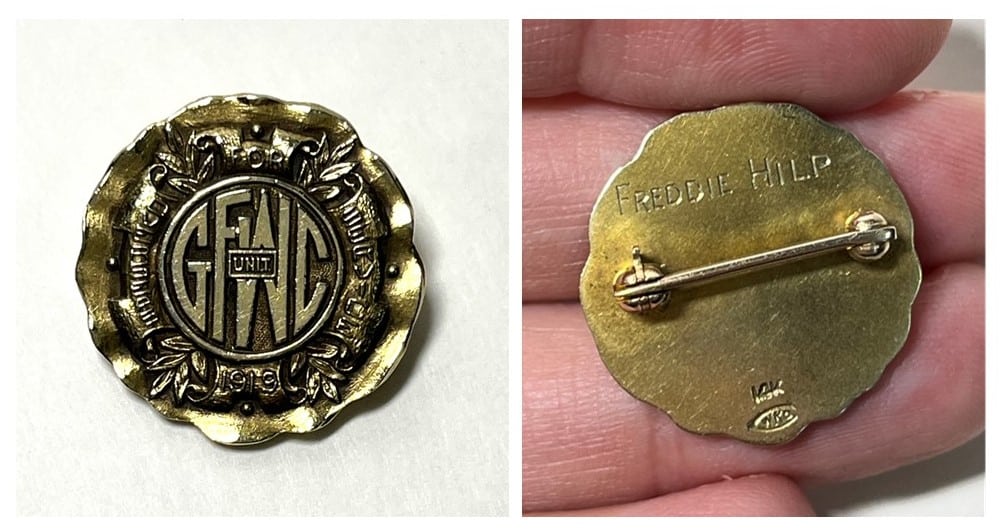
I am not embarrassed to admit that when Wendy described her successful bid and said “I think the name on the back was something like Freddie…?” I literally jumped up and down with excitement. It turns out that Leslie Holt died in 2017; her widower, not aware of the connection to Leslie’s earlier donation, put this piece from her collection up for sale. The muse of history was looking out for us, and Wendy spotted the auction. When she told Mr. Holt she would be donating the pin to the WHRC to join Leslie’s earlier donation, he said she would have been so glad to know that her grandmother’s story was of such importance to us.
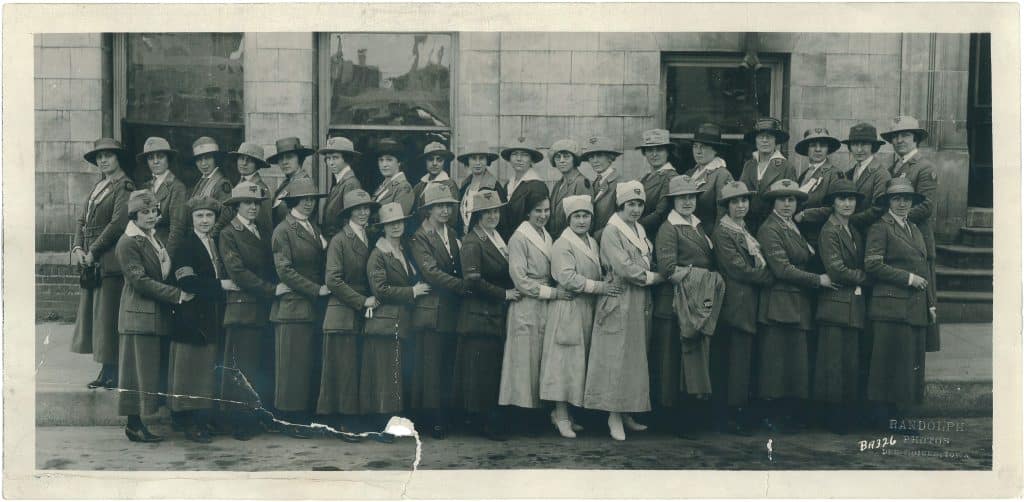
Group photo of the Overseas Unit women who attended the General Federation of Women’s Clubs Biennial Convention in Des Moines, Iowa, in 1920. Though the women are not identified, I think that Freddie is standing in the front row, seventh from left (in the detail view used earlier, she’s third from the left).
A huge thank you to Leslie and Rick Holt for sharing Freddie’s story with us; Wendy Carriker, for keeping an eagle eye on GFWC-related auctions; and Morgan Davis, who cataloged the 263 photos shortly after their donation.
Remember to check back next month for more stories from GFWC history (and present)! To learn more about the WHRC collections, visit the WHRC page or contact us at whrc@gfwc.org.
Joanna Church is the Women’s History and Resource Center Librarian at GFWC Headquarters in Washington, DC. She oversees the WHRC collection, handles research requests, and loves sharing our unique resources with fellow lovers of women’s history.
Learn More about the WHRC
The Women’s History and Resource Center